We may not have the course you’re looking for. If you enquire or give us a call on 01344203999 and speak to our training experts, we may still be able to help with your training requirements.
Training Outcomes Within Your Budget!
We ensure quality, budget-alignment, and timely delivery by our expert instructors.
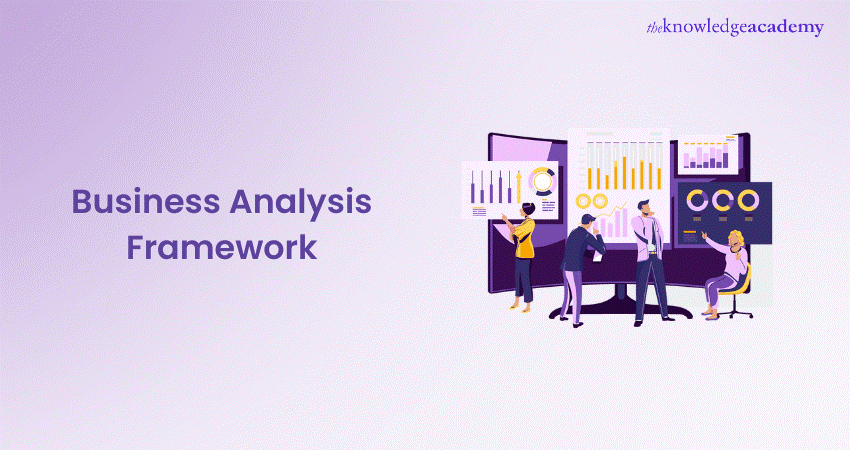
Most businesses strive for effective analysis as compass guiding organisations toward success. Business Analysis Frameworks serve as invaluable tools for navigating complex decisions and strategy development. However, What is a Business Analysis Framework?
A Business Analysis Framework is used by Business Analysts to scrutinise and decipher various aspects of an organisation. These frameworks include a variety of models, methodologies, and techniques, each tailored to specific needs. This blog delves deep into Business Analysis Frameworks, while exploring the popular frameworks, components, and how they aid businesses in achieving their goals.
Table of Contents
1) What is a Business Analysis Framework?
2) Importance of Framework
3) Steps in Business Analysis Framework
4) Techniques used in Framework
5) Common Business Analysis Frameworks
6) Conclusion
What is a Business Analysis Framework?
A Business Analysis Framework is a structured approach and methodology used by Business Analysts to understand, assess, and improve various aspects of a business. It provides a systematic way to identify, define, and address business needs and challenges. This framework typically includes processes, techniques, and tools for gathering and analysing data, defining requirements, and proposing solutions. It helps ensure that business analysis efforts are consistent, comprehensive, and aligned with organisational goals. A well-defined framework can streamline decision-making, enhance communication, and ultimately drive business transformation and improvement. It serves as a guide for Business Analysts to navigate complex business environments, whether in process improvement, software development, or strategic planning.
Importance of Framework
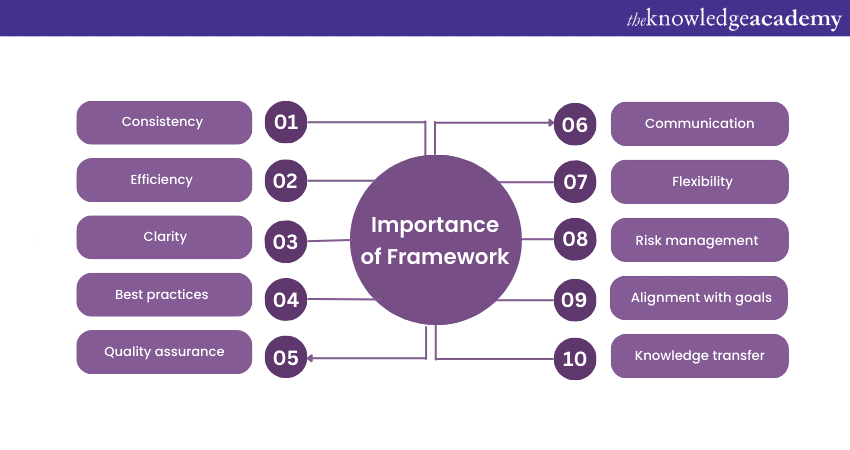
The importance of a framework in various domains, including business analysis, is paramount for several reasons:
a) Consistency: A framework provides a structured approach, ensuring that Business Analysts consistently follow a set of practices and procedures. This consistency is essential for reliable and comparable results.
b) Efficiency: By offering a well-defined path for conducting business analysis activities, a framework streamlines the process. It saves time and resources, allowing analysts to focus on core tasks.
c) Clarity: Frameworks help in defining the scope and objectives of a project or analysis. They offer a clear roadmap, ensuring everyone involved understands the goals and expectations.
d) Best practices: Frameworks are often developed based on industry best practices and standards. They incorporate the collective knowledge and expertise of professionals, resulting in effective and proven methodologies.
e) Quality assurance: Using a framework ensures that analysis activities meet a certain quality standard. This, in turn, enhances the quality of outcomes, reducing errors and rework.
f) Communication: Frameworks often include standardised documentation and reporting formats. This aids in clear communication among team members, stakeholders, and decision-makers.
g) Flexibility: While providing structure, frameworks are designed to be adaptable. They can be customised to fit specific project needs and can accommodate changes in scope or objectives.
h) Risk management: By guiding analysts through risk assessment and mitigation, frameworks help identify potential issues and develop strategies to address them effectively.
i) Alignment with goals: Frameworks are typically designed to align with the overall goals and objectives of an organisation. They ensure that business analysis efforts are directly linked to strategic outcomes.
j) Knowledge transfer: Frameworks serve as valuable educational tools. New analysts can quickly learn established practices, and experienced professionals can continuously improve their skills.

Steps in Business Analysis Framework
The Business Analysis Framework is typically organised into five distinct sections or phases, each serving a specific purpose in the analysis process. These sections guide Business Analysts in identifying, analysing, and documenting requirements while ensuring a structured and comprehensive approach. Here is a breakdown of these sections:
a) Investigate the situation: In this initial phase, the focus is on understanding the current challenges and issues faced by the business. The scope should be broad to ensure a thorough analysis of the existing situation. It's essential not to jump to conclusions prematurely, emphasising the need for a comprehensive examination.
b) Consider perspectives: This phase revolves around understanding the viewpoints of business owners and stakeholders. It involves managing stakeholders effectively and recognising those with decision-making authority. Feedback and input from stakeholders are crucial when proposing solutions, and their opinions should be given due consideration.
c) Analyse needs: During this stage, the current business system is thoroughly analysed to identify opportunities for improvement and enhancements. A gap analysis is conducted to compare the existing processes with the desired ones, allowing for a focus on process enhancement. Three primary questions are addressed:
Where the process needs to be.
Where it currently stands.
What changes are required to achieve the desired productivity.
d) Evaluate options: This phase is dedicated to evaluating potential options and improvements identified earlier in the process. A comparative analysis is performed by assessing existing systems against the desired systems, facilitating decision-making regarding which opportunities to pursue.
e) Define requirements: This phase involves detailed documentation activities for Business Analysts. They collaborate with key stakeholders and business owners to define the requirements. Requirements are documented meticulously to ensure that they align with the objectives and expectations of the business.
These five sections guide Business Analysts through a structured and comprehensive analysis process, ultimately leading to well-defined requirements and informed decision-making. Each phase plays a crucial role in the overall success of the analysis and its ability to address business challenges effectively.
Techniques used in Framework
Business Analysts rely on various tools and techniques to conduct effective analysis. Here are some of the most widely used methods:
SWOT Analysis
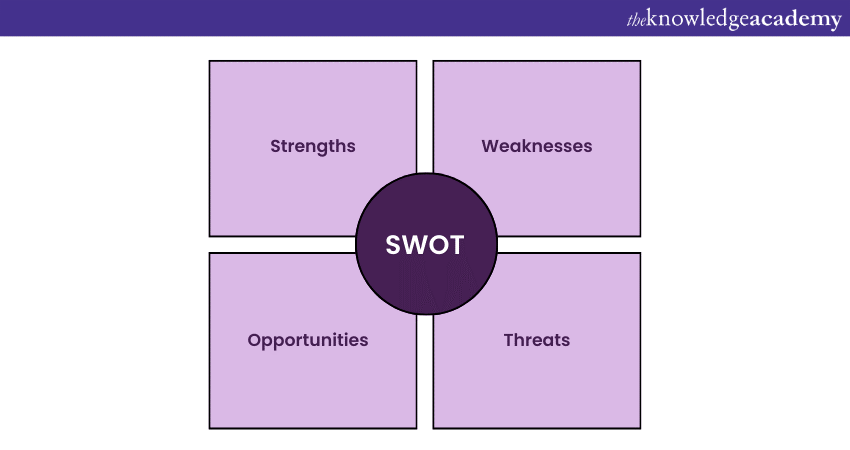
SWOT analysis is a strategic framework that assesses a business or organisation on four crucial components:
a) Strengths: These encompass all internal, positive attributes and characteristics that define the organisation's foundation. Strengths are the areas to emphasise and build upon.
b) Weaknesses: Weaknesses represent internal vulnerabilities and shortcomings within the business process. Identifying weaknesses is crucial for eliminating or mitigating them through strategies and improvements.
c) Opportunities: Opportunities pertain to external factors that hold the potential for business growth. These factors should be recognised and leveraged to expand the organisation's products or services.
d) Threats: Threats encompass external factors that could jeopardise the business's survival. This comprehensive analysis, which evaluates these four parameters, provides valuable insights for informed decision-making and strategic planning.
Strengths and weaknesses are internal factors, whereas opportunities and threats are external factors. SWOT analysis helps organisations identify their current position and develop strategies to capitalise on strengths, address weaknesses, exploit opportunities, and defend against threats to achieve their goals.
MOST Analysis
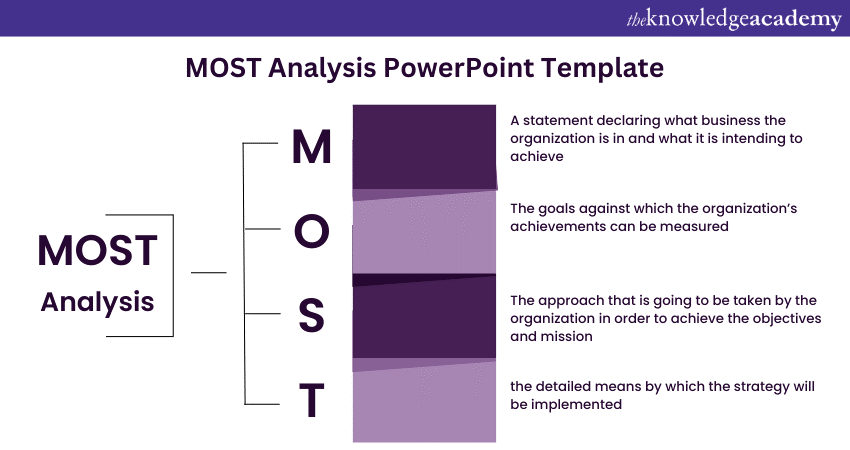
MOST analysis is a powerful strategic tool employed by Business Analysts to enhance organisational performance. It consists of four key elements:
a) Mission: A successful company must have a well-defined mission that serves as its foundation. This mission sets the broader goals and objectives of the organisation.
b) Objective: Objectives are integral to the mission and should be SMART (Specific, Measurable, Achievable, Realistic, and Time-bound). Delays in achieving objectives can hinder organisational success.
c) Strategy: Strategy is the action plan that organisations adopt to realise their goals. It outlines how to achieve their defined objectives.
d) Tactics: Tactics are the practical methods used to implement strategies effectively. They should be straightforward and understandable for all employees. This is often done to rejuvenate the organisation's purpose and mission, ensuring they remain relevant and well-defined.
MOST analysis ensures that an organisation's mission and objectives are aligned with its strategies and tactics, promoting a clear direction and efficient goal achievement.
Business Process Modelling
Business Process Model (BPM) entails the graphical representation of an organisation's business processes and specific workflows. It serves as a valuable tool for entrepreneurs, offering insights and suggestions to enhance the profitability and scalability of their existing models.
The International Institute of Business Analysis (IIBA) plays a pivotal role in BPM, including:
a) Strategic planning: Involves developing long-term strategies for business growth.
b) Business model analysis: Evaluates existing business models for optimisation.
c) Definition and design of business processes: Focuses on outlining and structuring business processes for efficiency.
d) Technical analysis for complex solutions: Assesses complex solutions from a technical perspective.
BPM is a widely-used analytical technique, particularly in the IT industry, enabling teams to visualise and streamline the execution process for improved analysis and decision-making.
Non-Functional Requirement Analysis
Non-Functional Requirement (NFR) Analysis serves as a vital technique, particularly when addressing changes in the technical solution for a specific problem. Business Analysts employ this approach to ascertain system performance and data storage requirements, ensuring the efficient handling of live data.
NFR analysis is an iterative process, carried out during the analysis phase and then implemented in the design phase. The primary non-functional requirements encompass:
a) Performance: Evaluating how the system performs under various conditions and loads.
b) Security: Assessing measures to protect data and systems from unauthorised access.
c) Logging: Determining how system activities are logged and monitored.
d) Reliability: Ensuring the system operates consistently without failures or disruptions.
Brainstorming
Brainstorming sessions are a crucial aspect of the Business Analyst's toolkit, serving to capture client needs and generate innovative solutions. In these collaborative gatherings, groups of individuals converge to address complex issues and provide valuable insights into the business.
Brainstorming sessions are characterised by the following:
a) Group dynamics: Unlike solitary endeavors, brainstorming involves group participation.
b) Unique problem focus: These sessions are dedicated to resolving specific questions or challenges, such as identifying the primary factors causing project delays.
c) Out-of-the-box thinking: Brainstorming encourages creative thinking, often leading to unconventional ideas.
d) Quantity of Ideas: More ideas are encouraged, as a larger pool of options enhances the quality of solutions.
This technique's ability to generate diverse ideas, perform root cause analysis, and propose solutions makes it a fundamental tool used in conjunction with various other business analysis methodologies, including SWOT analysis and MOST analysis.
Requirements Analysis
Requirement analysis is a pivotal phase in the product life cycle, commencing when stakeholders seek a solution. Business Analysts embark on numerous interviews to grasp the fundamental intent behind the requirements. This essential process includes elements like formulating questions, capturing insights, interpreting information, and conducting workshops.
Beyond interviews, Business Analysts employ various techniques to enhance requirement analysis:
a) Brainstorming: Group sessions for generating innovative ideas and solutions.
b) Shadowing: Observation of real business environments to understand end-user reactions and issues. This can be passive (non-intrusive) or active (interactive).
c) Prototyping: Building low-fidelity prototypes to gather relevant feedback and enhance understanding of use cases. This iterative process allows business owners to provide detailed insights as they engage with the design.
These techniques ensure thorough requirement analysis, enabling Business Analysts to bridge the gap between stakeholders' needs and effective solutions.
CATWOE
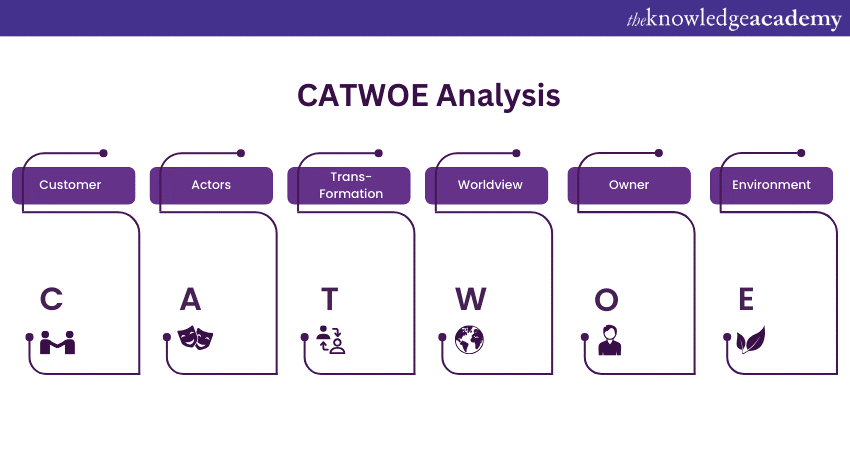
The CATWOE framework is a valuable tool for guiding the thought process in business analysis. It offers a structured approach to comprehending the business goal, identifying vulnerabilities, and assessing how the proposed solution will impact the organisation and its stakeholders.
CATWOE is an acronym representing different key perspectives:
a) Customers: Understanding the needs and expectations of the end-users or customers.
b) Actors: Identifying the individuals or entities directly involved in the business process.
c) Transformation: Analysing how the process transforms inputs into outputs.
d) Worldview: Examining the broader context and the way the business operates within its environment.
e) Owners: Recognising those responsible for the process and its outcomes.
f) Environmental Restrictions: Considering external factors and constraints influencing the business.
By systematically evaluating these aspects, a Business Analyst gains a comprehensive understanding of the business situation and can make informed decisions to address challenges and opportunities.
User Story Mapping
User Story Mapping is a contemporary business analytics technique frequently employed within the Agile development model. Agile emphasises flexibility, iterative development, and direct user involvement in the design process. User Story Mapping aligns perfectly with these principles.
In this approach, project requirements are primarily derived from users' perspectives, making it highly effective. It allows teams to visualise the user experience by creating a narrative that outlines the user's journey through the product. This user-centric focus helps in better understanding user needs and priorities, ensuring that the final product aligns with user expectations.
User Story Mapping is particularly valuable in Agile projects, where continuous iterations and close collaboration with end-users are central to the development process. It serves as a roadmap that guides the development team in creating a product that genuinely meets user requirements and delivers value.
PESTLE Analysis
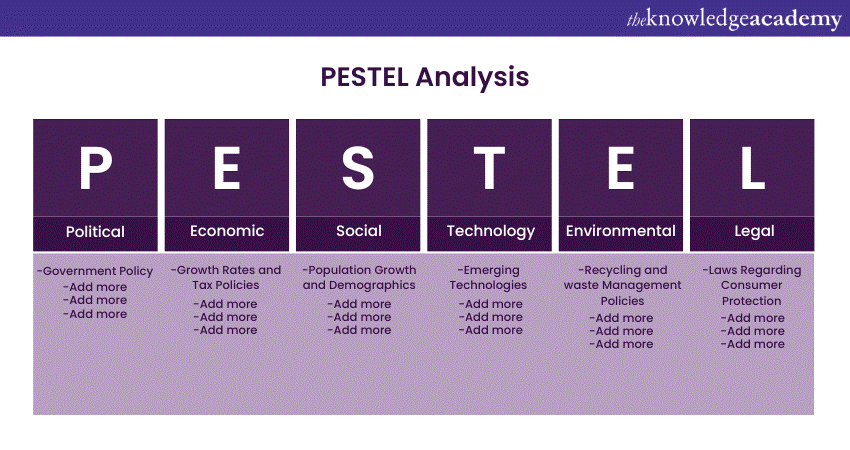
PESTLE analysis, an essential business analysis tool, takes into account several environmental factors that significantly influence businesses. It's a framework for assessing the external macro-environmental elements that an organisation needs to consider when formulating its strategies. These factors encompass:
a) Political: This dimension pertains to government policies, regulations, and initiatives that can affect business operations.
b) Economic: Economic factors cover local and global economic conditions like interest rates, inflation, labor costs, energy prices, and more.
c) Social: Social factors delve into aspects such as population demographics, culture, education, media, lifestyles, and social trends.
d) Technological: Technological factors encompass innovations, advancements, and their impact on industries and markets.
e) Legal: Legal factors include all forms of legislation and regulations, particularly those affecting businesses, employment, and workplace conditions.
Environmental: The environment dimension takes into consideration the environmental impact of businesses, including areas like pollution, recycling, and waste management.
Assessing these PESTLE factors enables organisations to better understand the challenges and opportunities presented by their external environment, informing their strategic planning and decision-making processes.
Common Business Analysis Frameworks
Business Analysis Frameworks are essential tools for assessing and strategising in various aspects of an organisation. Here are five prominent frameworks used by Business Analysts:
a) Michael Porter’s Five Forces Model: This widely recognised framework analyses the competitive forces within an industry. It considers factors like rivalry among competitors, threats from new entrants, substitute products, supplier power, and buyer power. High force levels indicate greater competition and a need for a comprehensive business viability assessment before entering such industries.
b) Hambrick and Fredrickson’s Strategy Diamond: This model focuses on the components of a successful strategy. It consists of five key elements: Arenas, Vehicles, Differentiators, Staging, and Economic Logic. A strategy should consider all these elements, making choices that reinforce each other to create a sound and sustainable strategy.
c) Treacy and Wiersema’s Value Disciplines: This framework offers three value disciplines for becoming a market leader: Product Leadership (offering innovative products), Operational Excellence (producing cost-effective products), and Customer Intimacy (providing exceptional customer service and relationship management).
d) Ansoff Matrix: This model outlines four growth strategies: Market Penetration (expanding in existing markets), Market Development (expanding into new markets), Product Development (offering new products in existing markets), and Diversification (entering new markets with new products). Each move to a new quadrant involves increased risk.
e) Boston Consulting Group (BCG) Growth-Share Matrix: This tool helps businesses assess their growth opportunities by evaluating their product or service portfolio. It categorises business units into Dogs, Question Marks, Cash Cows, and Stars based on market growth and relative market share. The matrix aids in portfolio analysis and corporate strategy framing.
Conclusion
A robust Business Analysis Framework serves as a compass in the corporate landscape, guiding professionals through the intricate world of decision-making. It empowers organisations to harness their strengths, navigate challenges, and seize opportunities, ultimately fostering success and innovation. By understanding and implementing these invaluable tools and techniques, businesses can adapt and thrive in an ever-evolving marketplace.
Frequently Asked Questions
Upcoming Business Analysis Resources Batches & Dates
Date
 BCS Certificate in Business Analysis Practice
BCS Certificate in Business Analysis Practice
Mon 13th May 2024
Tue 28th May 2024
Mon 10th Jun 2024
Mon 24th Jun 2024
Mon 8th Jul 2024
Sat 20th Jul 2024
Mon 22nd Jul 2024
Mon 5th Aug 2024
Mon 16th Sep 2024
Mon 30th Sep 2024
Mon 28th Oct 2024
Sat 2nd Nov 2024
Mon 25th Nov 2024
Mon 9th Dec 2024







 Top Rated Course
Top Rated Course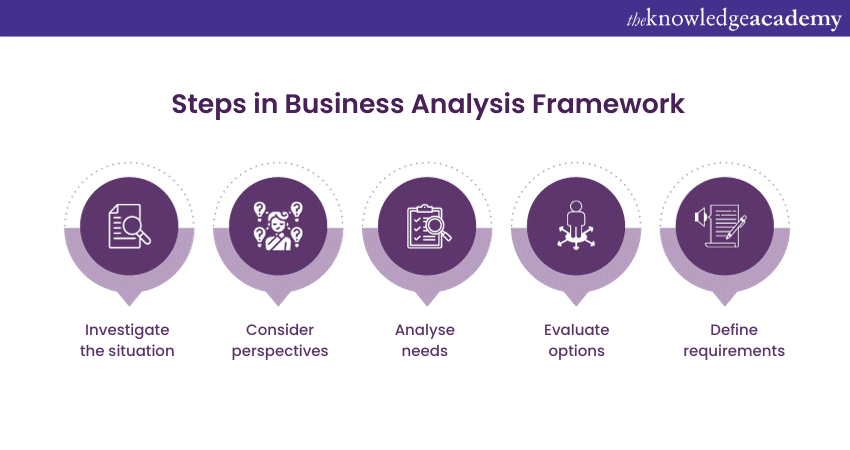



 If you wish to make any changes to your course, please
If you wish to make any changes to your course, please


